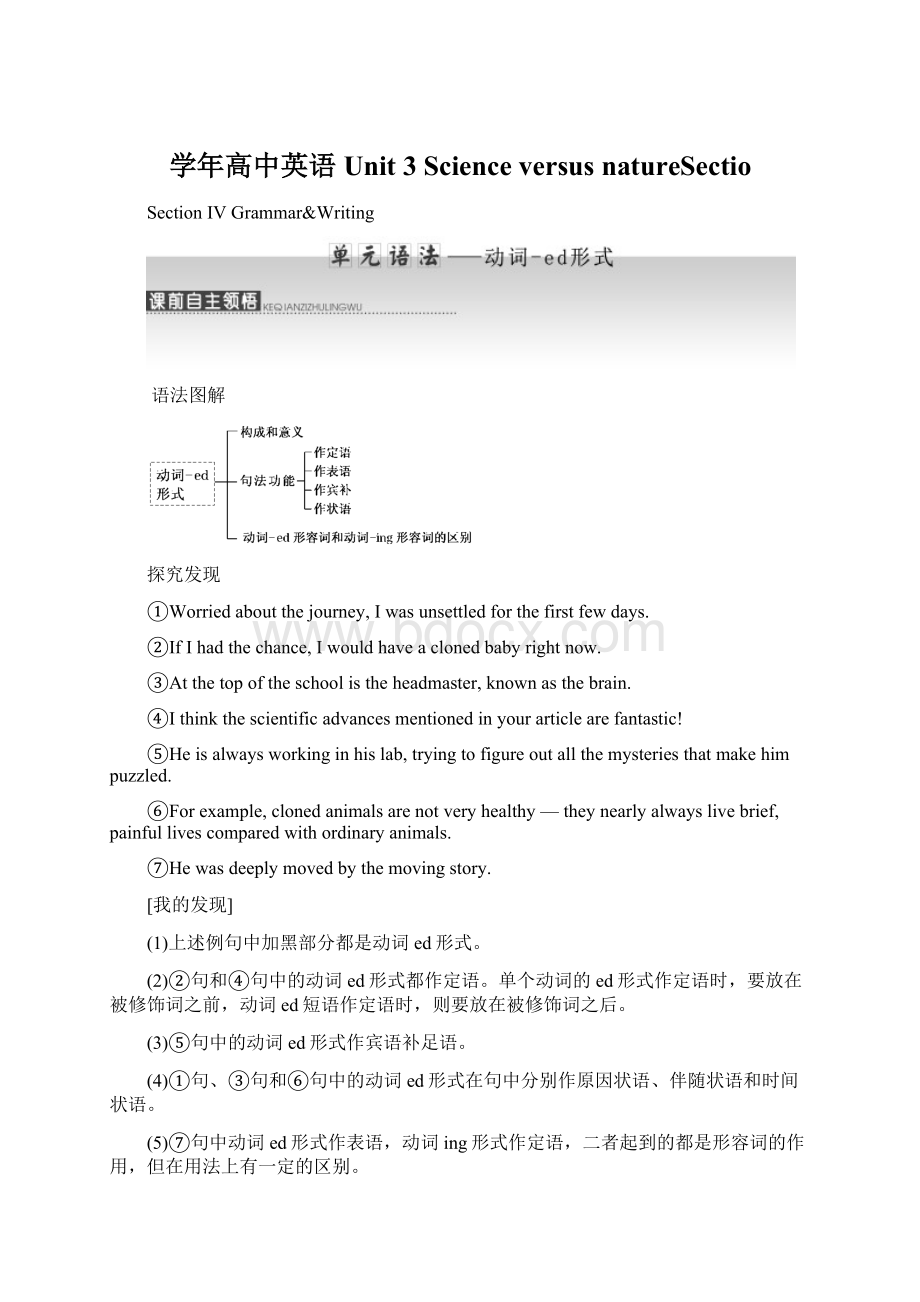学年高中英语 Unit 3 Science versus natureSectio.docx
《学年高中英语 Unit 3 Science versus natureSectio.docx》由会员分享,可在线阅读,更多相关《学年高中英语 Unit 3 Science versus natureSectio.docx(12页珍藏版)》请在冰豆网上搜索。

学年高中英语Unit3ScienceversusnatureSectio
SectionⅣGrammar&Writing
语法图解
探究发现
①Worriedaboutthejourney,Iwasunsettledforthefirstfewdays.
②IfIhadthechance,Iwouldhaveaclonedbabyrightnow.
③Atthetopoftheschoolistheheadmaster,knownasthebrain.
④Ithinkthescientificadvancesmentionedinyourarticlearefantastic!
⑤Heisalwaysworkinginhislab,tryingtofigureoutallthemysteriesthatmakehimpuzzled.
⑥Forexample,clonedanimalsarenotveryhealthy—theynearlyalwayslivebrief,painfullivescomparedwithordinaryanimals.
⑦Hewasdeeplymovedbythemovingstory.
[我的发现]
(1)上述例句中加黑部分都是动词ed形式。
(2)②句和④句中的动词ed形式都作定语。
单个动词的ed形式作定语时,要放在被修饰词之前,动词ed短语作定语时,则要放在被修饰词之后。
(3)⑤句中的动词ed形式作宾语补足语。
(4)①句、③句和⑥句中的动词ed形式在句中分别作原因状语、伴随状语和时间状语。
(5)⑦句中动词ed形式作表语,动词ing形式作定语,二者起到的都是形容词的作用,但在用法上有一定的区别。
一、动词ed形式的构成和意义
1.动词ed形式的构成
动词ed形式通常是由动词后加“ed”构成的,少数动词的ed形式有不规则变化形式。
注意:
动词ed形式无时态和语态的变化。
2.动词ed形式的意义
及物动词的ed形式既表被动,又表完成;不及物动词的ed形式只表完成,不表被动。
Thebooks,writtenbyLuXun,arepopularwithmanyChinesepeople.
鲁迅写的这些书,受到了许多国人的喜爱。
(表被动和完成)
Oncerecovered,hethrewhimselfintohisworkandmadeeveryefforttodoitwell.
他一康复就投身到他的工作中去并且尽一切努力把它做好。
(只表完成)
[即时演练1]
判断下列过去分词属于哪一种用法
A.只表被动 B.只表完成 C.既表被动又表完成
①Heisamanlikedbyallofus.A
②Heenjoysdrinkingboiledwater.B
③Thosechosenasteammembersmustbehereat7a.m.tomorrow.C
二、动词ed形式的句法功能
1.作定语
(1)单个的动词ed形式作定语一般放在被修饰词的前面(left除外),相当于一个形容词。
Theexcitedpeoplerushedintothebuilding.
激动的人们奔进了大楼。
Weneedmorequalifiedteachers.
我们需要更多合格的教师。
(2)动词ed短语作定语通常放在被修饰词的后面,相当于一个定语从句。
Thesuggestionmadebytheforeignexpertwasadoptedbythemanager.
外国专家提出来的建议被经理采纳了。
(3)动词ed短语作定语也可用作非限制性定语,前后用逗号隔开。
Themeeting,attendedbyonethousandstudents,wasagreatsuccess.
这次会议获得了很大的成功,共有一千名学生出席。
[名师点津] 动词ed形式作定语往往表示被动、完成;动词ing形式作定语表示主动、正在进行;不定式作定语则表示还未发生。
Thegirlstandingbythedoorismydaughter.
在门口站着的那个女孩是我的女儿。
Themeetingtotakeplacehereisveryimportant.
要在这里召开的会议很重要。
[即时演练2]
(1)用所给词的适当形式填空
①Haveyougotanythingtodo(do)thisevening?
②Tellthechildrenplaying(play)outsidenottomaketoomuchnoise.
③Allthebroken(break)windowshavebeenrepaired.
(2)完成句子
①上周一我们班开展了一次有组织的旅行。
OurclasswentonanorganizedtriplastMonday.
②污染了的水和空气对人的健康有害。
Thepollutedwaterandairareharmfultopeople'shealth.
2.作表语
(1)动词ed形式作表语主要表示主语的心理或所处的状态。
Don'ttouchtheglassbecauseitisbroken.
不要碰那个杯子因为它是破的。
Hefeltdisappointedafterhisrequestwasrefused.
他的请求被拒绝后,他感到很失望。
[名师点津] 有的动词ed形式作表语,相当于形容词,且大部分已转化为形容词,常见的有:
delighted,disappointed,discouraged,drunk,amused,astonished,hurt,interested,crowded,tired,satisfied,pleased,surprised,worried,excited,married,puzzled,upset等。
(2)过去分词作表语与被动语态的区别。
动词ed形式作表语,表示主语的性质、特征或状态。
用作表语的过去分词,被动意味很弱,主要表示动作的完成和状态。
此时的过去分词相当于一个形容词,其后常不跟by短语。
被动语态的动词ed形式,被动意味很强,句子主语为动作的承受者,后常跟“by+动作的执行者”。
MygrandfatherwasdelightedtohearIpassedmyexams.
我祖父听到我通过考试感到很高兴。
Thenewtissuesandorgansareusedtocurediseasesbydoctors.
新的组织和器官被医生用来治疗疾病。
[即时演练3]
判断下列句子中黑体部分属于哪种结构
A.系表结构 B.被动语态
①Weareinterestedincollectingstamps,raisingbirdsandfishing.A
②Morethan200peopleweretrappedinthebuildingbythebigfire.B
③I'mabitpuzzledthatIhaven'theardfromTomforsolong.A
④WeweregreatlymovedbywhatZhangLilihaddone.B
3.作宾补
动词ed形式作宾语补足语,其逻辑主语是句子的宾语。
宾语与宾语补足语之间是被动关系。
(1)后跟动词ed形式作宾语补足语的动词大致可分为以下三类:
①make,get,have,keep等使役动词。
Whenwillyougotothehospitalandhaveyourtoothexamined?
你什么时候去医院检查你的牙齿?
②see,hear,feel,find等表示感觉和心理状态的动词。
Shesawthethiefcaughtbypolicemen.
她看见小偷被警察抓住了。
Theoldmanfoundhishometownmuchchanged.
这位老人发现自己的家乡有了很大的变化。
③like,want,wish,order等表示希望、要求、命令等意义的动词。
Themanagerdoesn'tlikesuchquestionsdiscussedatthemeeting.
经理不喜欢在会上讨论这样的问题。
(2)“with/without+宾语+宾语补足语”结构。
Withhishomeworkdone,hestartedtowatchTV.
作业完成后,他开始看电视。
[即时演练4] 用所给词的适当形式填空
①Iheardmynamecalled(call)inthestreet.
②Hetriedtomakehimselfunderstood(understand)byhisstudentsinclass.
③Hewantedhisnameincluded(include)inthelist.
④Wemusthaveourwindowsrepaired(repair)beforewintercomes,orwe'llfreeze.
⑤Withthetaskcompleted(complete),wehadaglobaltravelling.
4.作状语
动词ed形式作状语,可以表示时间、原因、条件、让步、方式或伴随情况等,在作用上相当于相应的状语从句。
(1)表示时间,相当于一个时间状语从句。
AcceptedbytheParty(=AfterhewasacceptedbytheParty),hedecidedtodevotehislifetothecauseoftheParty.
入党以后,他决定献身于党的事业。
(2)表示原因,相当于一个原因状语从句。
Depressed(=Sincehewasdepressed),hewenttoseehiseldersister.
他感到沮丧,就去拜访他姐姐了。
(3)表示条件,相当于一个条件状语从句,有时过去分词前可用if等词。
Growninrichsoil(=Iftheyaregrowninrichsoil),theseseedscangrowfast.
如果种在肥沃的土壤里,这些种子能长得很快。
(4)表示让步,相当于一个though/although引导的让步状语从句。
Exhaustedbytherunning(=Though/Althoughtheywereexhaustedbytherunning),theywentonrunningaftertherobber.
尽管已经跑得筋疲力尽,但他们还是继续追赶着那个强盗。
(5)表示方式或伴随情况。